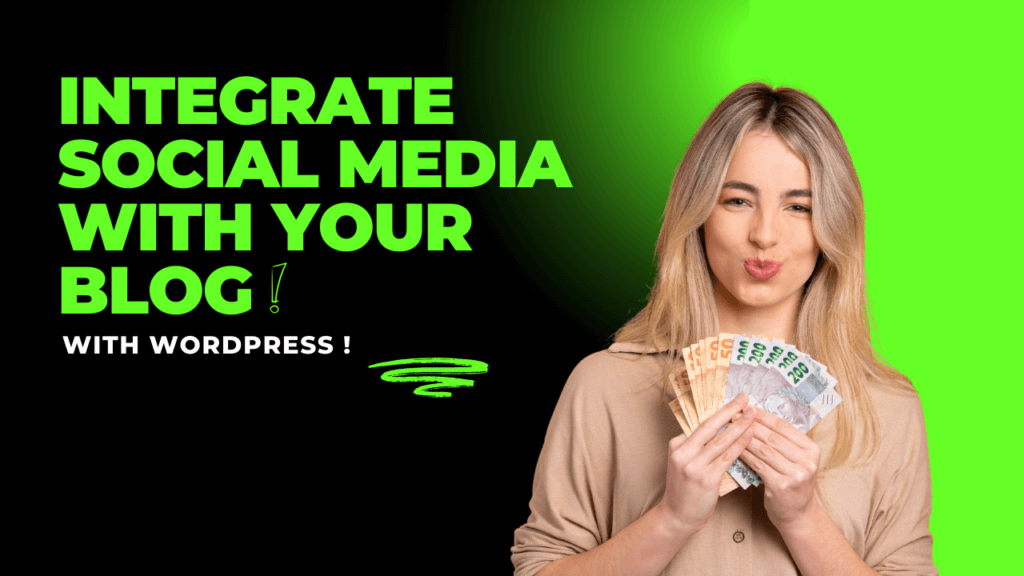Why Integrate Social Media with WordPress Blog?
Integrating social media with your WordPress blog has become essential for online growth and visibility. With billions of users on platforms like Facebook, Instagram, and Twitter, tapping into these networks can drive significant traffic to your blog. By connecting your WordPress site with social media, you can expand your reach, enhance user engagement, and encourage readers to share your content effortlessly. This integration also provides an opportunity to build a loyal community around your blog, fostering both interaction and trust.
In today’s digital landscape, it’s not enough to simply publish great content. You need to actively promote it to get noticed. Integrating social media with your WordPress blog allows you to share your posts across multiple channels in just a few clicks, saving time while boosting your online presence. Moreover, this integration helps improve your search engine rankings, as social signals like shares, likes, and comments are increasingly being considered by Google and other search engines.
Whether you’re a blogger, business owner, or marketer, understanding the value of social media integration is crucial. It creates a seamless connection between your blog and social media profiles, ensuring that your content is consistently reaching a wider audience. By using tools and plugins that easily integrate social media with your WordPress blog, you can simplify content sharing and create a stronger, more engaged online community.
Benefits of Social Media Integration
Integrating social media with your WordPress blog offers numerous benefits that go beyond just sharing your content. One major advantage is the ability to reach a larger, more diverse audience. When your readers can share your blog posts on their own social media profiles, your content is exposed to new readers who might not have discovered your site otherwise. Additionally, this integration helps in building credibility and trust, as social proof in the form of likes, shares, and comments adds validation to your content.
Another key benefit is the potential for enhanced brand recognition. Every time your blog post is shared, your brand’s visibility grows. This increases the likelihood of attracting new followers, customers, or clients. Moreover, social media integration enables you to connect more personally with your audience, responding to their comments and engaging in meaningful conversations, which fosters a stronger sense of community.
Increasing Engagement and Reach
One of the most significant outcomes of integrating social media with your WordPress blog is the ability to increase engagement and extend your reach. Social media platforms are designed for interaction, making it easier for your audience to engage with your content through likes, shares, and comments. This interaction not only boosts visibility but also creates a more dynamic relationship between you and your readers. Engaged readers are more likely to return to your blog, share your posts, and become loyal followers.
Social media integration also gives you access to powerful analytics tools that can help track how well your content is performing. By monitoring metrics like shares, clicks, and comments, you can refine your strategy to create more shareable and engaging content. This increased reach and interaction can translate into higher traffic, improved SEO, and ultimately more conversions for your blog. By integrating social media with your WordPress blog, you are leveraging the power of both platforms to achieve long-term success.

Understanding Social Media Integration in WordPress
So, what exactly is social media integration? In simple terms, it means connecting your blog to social media platforms in a way that lets you easily share content, engage with followers, and bring traffic back to your site. It’s like setting up a network of highways leading back to your blog, encouraging more people to visit and interact with your content.
Benefits of Integrating Social Media with Your WordPress Blog
Increased Visibility and Traffic
By linking your blog to social media, you’re opening up doors to millions of potential readers. Each share, like, or comment on your social media posts can bring a new visitor to your blog. The more eyes on your content, the greater your blog’s visibility becomes.
Improved User Engagement
Social media encourages interaction, and that’s exactly what you want for your blog. Engaged readers are more likely to comment, share, and come back for more, building a loyal audience over time.
Enhanced Content Reach and Sharing Capabilities
With social media integration, your readers can easily share your posts with their own networks. This amplifies your content’s reach beyond your immediate audience, creating a ripple effect that brings in more traffic and followers.
Preparing Your WordPress Blog for Social Media Integration
Before you start integrating social media, it’s crucial to assess your blog’s current setup. Ask yourself: is my blog optimized for sharing? Does my site have the right plugins and tools to support social integration? By setting clear goals, you can tailor your approach to match your desired outcome, whether it’s boosting traffic, enhancing engagement, or both.
Best Social Media Platforms for WordPress Blogs
Here’s a quick rundown of where to focus:
- Facebook: Great for sharing all types of content, especially longer posts and discussions.
- Twitter: Ideal for quick updates, links, and connecting with influencers.
- Instagram: Perfect for visual-heavy content, like photos and infographics.
- LinkedIn: Best for professional or industry-specific content.
- Pinterest: A must for blogs related to DIY, lifestyle, fashion, and recipes.
Top Plugins for Social Media Integration
Plugins can simplify social media integration. Here are some top options:
- Jetpack: Offers a suite of tools including social sharing, site stats, and more.
- Social Warfare: Excellent for creating visually appealing social share buttons.
- Monarch by Elegant Themes: Highly customizable with a focus on user experience.
How to Add Social Media Buttons to Your WordPress Blog
Adding social media buttons is one of the simplest ways to integrate social networks into your blog. Here’s how:
- Choose a Plugin: Use a plugin like Social Warfare or AddToAny.
- Install and Activate: Follow the plugin’s instructions to set it up.
- Customize Button Placement: Place buttons at strategic spots like the top of posts, at the end of articles, or in the sidebar.
Integrating Social Media Feeds into Your WordPress Blog
Embedding live social media feeds keeps your blog dynamic and up-to-date. For instance, you can use tools like Smash Balloon Social Photo Feed for Instagram or Custom Twitter Feeds to display your latest posts directly on your blog.
Using Social Media Auto-Sharing Tools for WordPress
Auto-sharing tools like Buffer and Revive Old Posts allow you to automatically share your blog posts to your social media accounts. This keeps your content fresh in your audience’s feeds without any extra effort on your part.
Creating Clickable Social Media Links within Your Blog Content
Clickable social media links are key to driving traffic back to your site. Tools like Pretty Links help you create short, easy-to-remember links that you can use within your blog content to promote your social media profiles.
Optimizing Your Blog Content for Social Sharing
Optimized content is crucial for social sharing. Make sure each post has a catchy headline, a featured image, and relevant meta descriptions. Use open graph tags to ensure your content looks great when shared on social media.
Best Practices for Social Media and WordPress Integration
To effectively integrate social media with your WordPress blog, following best practices is essential. This ensures a smooth, professional connection between your site and your social media profiles, amplifying your content’s visibility and reach. One crucial best practice is to use high-quality social media plugins that allow seamless sharing and interaction across multiple platforms. These plugins should be lightweight and optimized to ensure they don’t slow down your website’s performance.
Another best practice is to maintain consistent branding across your blog and social media channels. This includes using the same logos, color schemes, and tone of voice, which will help establish a cohesive brand identity. By ensuring consistency, you make it easier for your audience to recognize your blog content when it’s shared across social media. Lastly, regularly monitor and analyze your social media metrics. Understanding what content resonates with your audience helps refine your strategy, resulting in better engagement and traffic growth.
For the most effective results, always encourage readers to engage with your content by adding calls to action (CTAs) on your posts. Simple reminders to share, like, or comment can significantly increase your post’s exposure. By using these best practices, you can successfully integrate social media with your WordPress blog and maximize your online presence.
Optimizing Social Media Profiles
Optimizing your social media profiles is a critical step when you integrate social media with your WordPress blog. Your profiles act as the first impression for many potential readers and followers, so it’s essential to make them compelling and consistent with your blog’s branding. Start by ensuring that each profile features a clear, professional profile picture and cover image that represents your blog. In addition, use an engaging bio that succinctly describes what your blog is about and includes relevant keywords.
It’s also important to include a link to your WordPress blog on all your social media profiles. This will make it easy for users to access your content with just one click. Furthermore, regularly updating your profiles with fresh content, promotions, or blog posts will keep your audience engaged and signal to social media algorithms that your profile is active, which can boost your visibility. The more optimized your profiles, the better they work to drive traffic to your WordPress blog.
Crafting Engaging Content for Each Platform
Crafting content that resonates with your audience on each platform is essential for effective social media integration with your WordPress blog. Each social media network has its own style and audience, so tailoring your content to fit each platform is key. For example, Instagram thrives on visually appealing images and short captions, while Twitter (X) is better suited for concise, engaging text and timely updates. Facebook, on the other hand, allows for more in-depth posts and discussions, making it ideal for sharing longer blog updates and engaging with readers in the comments.
The key to crafting engaging content is to focus on value and interaction. Ensure your social media posts offer something valuable, whether it’s tips, insights, or entertainment, while also encouraging users to engage by asking questions, offering polls, or using hashtags. Each post should be optimized to attract attention on its respective platform while driving traffic back to your WordPress blog. By creating platform-specific content, you can boost engagement and successfully integrate social media with your WordPress blog for broader reach and higher interaction.
Conclusion
Integrating social media with your WordPress blog is no longer just an option—it’s a necessity for anyone looking to expand their online presence. By linking your blog with social platforms, you open the door to greater visibility, engagement, and traffic, all while building a loyal community around your content. A well-executed integration not only makes it easier for readers to share your posts but also strengthens your blog’s SEO by boosting social signals that search engines value. To stay ahead in today’s digital landscape, it’s essential to leverage the combined power of WordPress and social media to maximize your blog’s potential.
Following best practices, such as using the right plugins and optimizing your social media profiles, ensures a seamless and efficient connection between your blog and various social networks. By paying attention to your audience’s preferences on each platform, you can craft content that encourages interaction and keeps readers engaged. Ultimately, integrating social media with your WordPress blog helps build a sustainable, growth-focused online strategy.
Final Tips for Social Media Integration
As you integrate social media with your WordPress blog, there are a few final tips to keep in mind for optimal results. First, consistency is key. Ensure that you post regularly across all social platforms and keep your blog’s branding aligned with your social media profiles. Regular updates and engaging content will keep your audience interested and boost your visibility across social channels.
Another crucial tip is to track performance through analytics tools. Platforms like Google Analytics, Facebook Insights, and Twitter Analytics provide valuable data on how well your blog posts perform on social media. Use this information to tweak your content strategy and optimize your sharing schedule. Lastly, always engage with your followers. Responding to comments and messages creates a more personal connection, encouraging more loyalty and interaction from your audience.
Growing Your Audience with WordPress and Social Media
Combining WordPress with social media is one of the most effective ways to grow your audience. When you integrate social media with your WordPress blog, you’re not only increasing the chances of people discovering your content, but you’re also creating multiple avenues for your readers to share it. This multiplier effect is key to expanding your reach beyond just organic search traffic.
Additionally, using social media as a promotional tool for your blog allows you to interact directly with your audience. By engaging with your readers through comments, shares, and messages, you create a community that values your content. Over time, this active engagement leads to more loyal followers, better retention, and ultimately, a growing audience. By following these strategies, you can successfully use both WordPress and social media to build and maintain a thriving online presence.
FAQs
- How often should I share my WordPress blog posts on social media?
- It’s best to share each post multiple times over the first week and then periodically after that to keep it fresh in your audience’s mind.
- Which is the best plugin for social media integration on WordPress?
- Social Warfare and Jetpack are among the best options for seamless integration.
- Is it necessary to integrate all social media platforms?
- No, focus on the platforms that are most relevant to your audience and niche.
- How can I improve social engagement with my WordPress blog?
- Engage actively with comments, use compelling visuals, and regularly share updates.
- What are the risks of not integrating social media with my blog?
- You could miss out on significant traffic, engagement, and growth opportunities.


